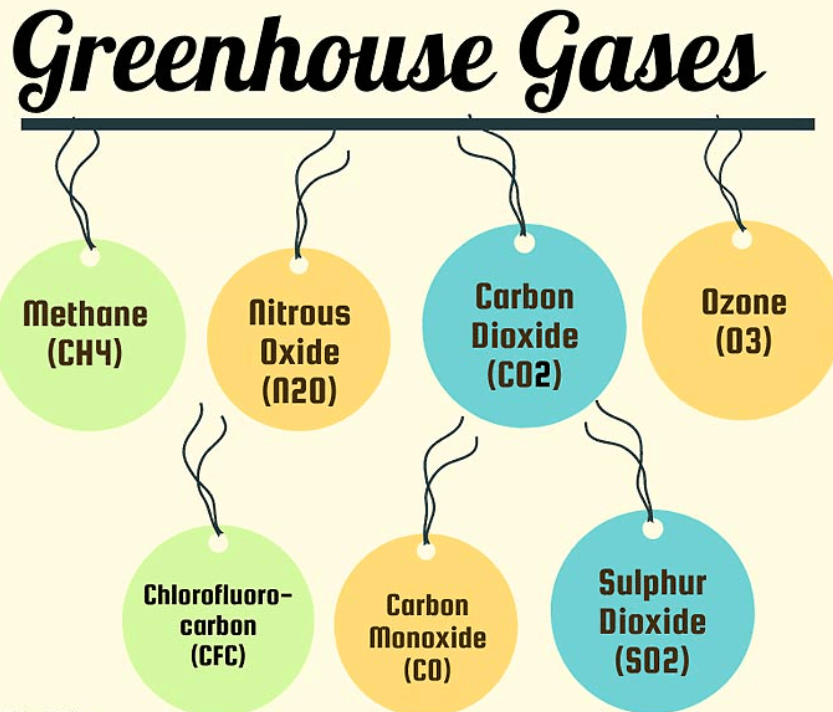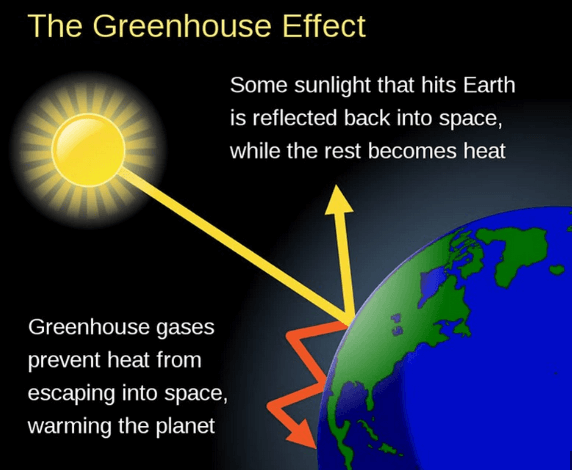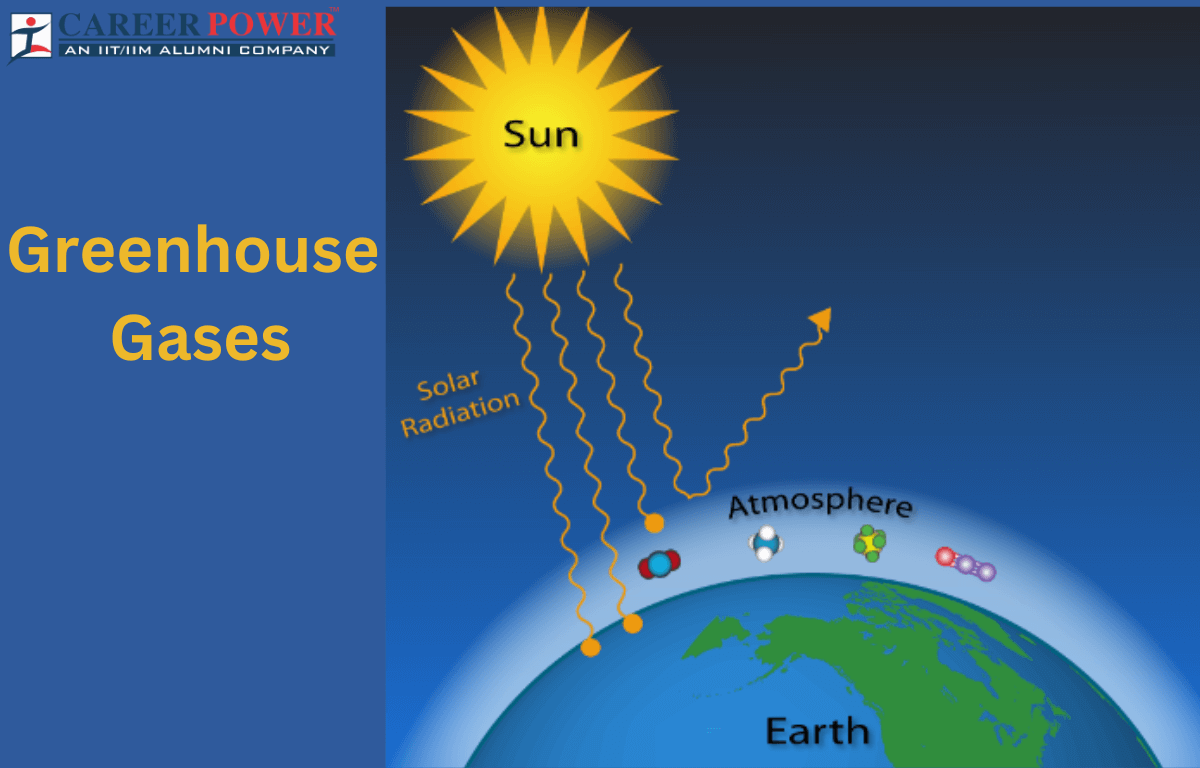In biology, the Greenhouse effect and greenhouse gases are intimately connected in Earth’s delicate climate system. Greenhouse gases, including carbon dioxide and methane, act as a natural blanket for our planet. They intercept and re-emit some of the heat energy radiated from the Earth’s surface, helping to maintain temperatures suitable for life. This whole process is popularly known as the greenhouse effect.
Greenhouse Gasses Definition
Greenhouse gases (GHG) are gases in Earth’s atmosphere that trap heat from the sun, leading to the greenhouse effect and warming of our planet. The most common greenhouse gases include carbon dioxide (CO2), methane (CH4), and nitrous oxide (N2O). These gases are released into the atmosphere through activities like burning fossil fuels, deforestation, and agriculture, contributing to climate change and global warming. Efforts to reduce greenhouse gas emissions are crucial for mitigating the impacts of climate change.
Different Greenhouse Gases
The greenhouse gases contribute to the greenhouse effect to varying degrees, with carbon dioxide being the most prevalent and well-known greenhouse gas associated with human activities and climate change.

| Different Greenhouse Gases | ||
| Greenhouse gas | Chemical Formula | Primary Source |
| Carbon Dioxide | CO2 | Fossil fuel combustion, deforestation, industrial processes. |
| Methane | CH4 | Livestock digestion, rice cultivation, natural gas production, landfills. |
| Nitrous Oxide | N2O | Agricultural activities, industrial processes, fossil fuel combustion. |
| Water Vapor | H2O | Natural part of the atmosphere, but its concentration can vary with temperature and humidity. |
| Chlorofluorocarbons (CFCs) | Various | Refrigeration, air conditioning, aerosol propellants (largely phased out due to ozone depletion). |
| Hydrofluorocarbons (HFCs) | Various | Used as replacements for CFCs in some applications like air conditioning and refrigeration. |
| Perfluorocarbons (PFCs) | Various | Industrial processes, semiconductors manufacturing, and refrigeration. |
| Sulfur Hexafluoride | SF6 | Electrical transmission and distribution, some industrial applications. |
What is the Greenhouse Effect?
The greenhouse effect is a process that occurs in Earth’s atmosphere. It’s the process by which certain gases, known as greenhouse gases, trap heat from the sun and prevent it from escaping back into space. This trapped heat helps maintain the Earth’s temperature at a level suitable for sustaining life.

While the natural greenhouse effect is essential for maintaining a livable temperature on Earth, human activities, such as the burning of fossil fuels and deforestation, have increased the concentration of greenhouse gases in the atmosphere. This enhanced greenhouse effect is leading to global warming and climate change, with potentially serious consequences for ecosystems and human societies. Efforts to reduce greenhouse gas emissions are critical to mitigating these effects.
Causes of Greenhouse Effect
The greenhouse effect is primarily caused by the increased concentration of greenhouse gases in the Earth’s atmosphere. These gases trap heat from the sun and prevent it from escaping into space, leading to a warming effect. The main factors contributing to the greenhouse effect include:
- Carbon Dioxide (CO2) Emissions: The burning of fossil fuels (coal, oil, and natural gas) for energy, transportation, and industrial processes releases large amounts of CO2 into the atmosphere.
- Methane (CH4) Emissions: Methane is released from livestock, rice paddies, landfills, and natural gas production. It is a potent greenhouse gas, although it doesn’t persist in the atmosphere as long as CO2.
- Deforestation: Cutting down trees and clearing land for agriculture reduces the Earth’s ability to absorb CO2 through photosynthesis, contributing to higher CO2 levels.
- Industrial Processes: Certain industrial activities release greenhouse gases, such as chlorofluorocarbons (CFCs), hydrofluorocarbons (HFCs), and perfluorocarbons (PFCs).
- Land Use Changes: Alterations in land use, such as urbanization and agricultural expansion, can affect the Earth’s surface properties, leading to changes in heat absorption and emission.
- Natural Factors: Natural sources of greenhouse gases include volcanic eruptions, wildfires, and the release of methane from wetlands.
Results of Greenhouse Effects
It’s very important to note that while the natural greenhouse effect is essential for maintaining a habitable temperature on Earth, human activities, primarily the burning of fossil fuels and deforestation, have intensified this effect, leading to accelerated global warming and its associated impacts. Efforts to mitigate these effects include reducing greenhouse gas emissions and transitioning to more sustainable energy sources.
- Global Warming: The primary effect of the greenhouse effect is the warming of the Earth’s surface temperatures. Greenhouse gases, such as carbon dioxide, methane, and water vapor, trap heat from the sun in the atmosphere, preventing it from escaping into space. This trapped heat frequently raises the average temperature of the planet.
- Climate Change: The increase in global temperatures due to the greenhouse effect leads to climate change. This includes more frequent and serve weather events like heatwaves, hurricanes, droughts, and floods. It can also disrupt ecosystems and alter precipitation patterns.
- Rising Sea Levels: As global temperatures rise, polar ice caps and glaciers melt, causing sea levels to rise. This can result in coastal erosion, increased coastal flooding, and the displacement of communities living in low-lying coastal areas.
- Ocean Acidification: The excess CO2 in the atmosphere is absorbed by the oceans, leading to ocean acidification. This harms marine life, particularly coral reefs and shellfish, as it disrupts their ability to build calcium carbonate structures.
- Economic Impacts: Climate-related disasters, such as hurricanes and wildfires, can cause extensive damage to infrastructure and lead to significant economic costs.
How does the Greenhouse Effect Work?
The greenhouse effect is a natural process that warms the Earth’s surface. Here we have mentioned the working of the greenhouse effect.
- Solar Radiation: The Sun emits energy in the form of sunlight, which contains various types of electromagnetic radiation, including visible light and infrared radiation.
- Absorption: Some of this solar radiation is absorbed by the Earth’s surface, warming it.
- Infrared Radiation: The Earth then emits this absorbed energy back into space in the form of infrared radiation (heat).
- Greenhouse Gases: Greenhouse gases in the earth’s atmosphere, such as carbon dioxide (CO2), methane (CH4), and water vapor (H2O), trap some of this outgoing infrared radiation. They act like a blanket, preventing some of the heat from escaping into space.
- Warming Effect: This trapped heat raises the temperature of the Earth’s surface and lower atmosphere, making the planet habitable for life. Without the greenhouse effect, the Earth would be too cold to support life.
However, human activities, such as the burning of fossil fuels and deforestation, have increased the concentration of greenhouse gases in the atmosphere.



 50 Vegetables Name for Kids in English a...
50 Vegetables Name for Kids in English a...
 Food Chain: Definition, Types, Examples,...
Food Chain: Definition, Types, Examples,...
 Human Respiratory System: Definition, Di...
Human Respiratory System: Definition, Di...













